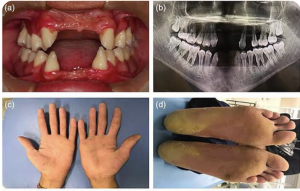Papillon-Lefèvre Syndrome
Papillon-Lefèvre syndrome (PLS) is a rare genetic condition that affects children between the ages of one and five. It is inherited in an autosomal recessive manner. It results from alterations of the CTSC gene; which regulates the production of cathepsin C enzyme. PLS is characterized by the appearance of hyperkeratotic patches on the palms and soles, as well as severe inflammation and deterioration of the structures that surround and support the teeth (periodontium).
Clinical Presentation:
Oral features:
Severe gingivostomatitis and periodontitis are the most common symptoms of PLS. In patients suffering from PLS, deciduous teeth erupt in the expected order, with normal structure and shape, at the appropriate ages. However, gingiva becomes inflamed during the first year after the eruption of deciduous teeth, followed by fast periodontal deterioration evidenced by visible reddish and swollen gingiva, severe bone resorption, and deep periodontal pockets out of which pus exudates in response to minimal pressure. Due of the hypermobility of the teeth, mastication is quite uncomfortable in those patients. A foul smelling mouth odor is usually present. Around the age of 4-5 years, the child’s deciduous teeth fall out prematurely, and the child becomes entirely edentulous, with gingiva returning to its normal status. Nevertheless, with the eruption of permanent or successor teeth, periodontitis occur again. By early adolescence, the majority of the successor teeth will fall out.
Cutaneous features:
PLS is marked by the appearance of dry, scaly patches of skin (hyperkeratosis) in children between the ages of one and five; it is manifested simultaneously with oral manifestations. These patches most commonly affect the palmar aspect of the hands and the plantar aspect of the feet –although they can also affect the knees and elbows. The skin of those who are affected can be abnormally red and thick, but it can also vary in texture and color. Skin lesions may worsen in cold weather, making walking extremely difficult.
Management:
A multidisciplinary approach involving a team of a dermatologist, a pediatrician and a dentist is crucial for patients with PLS. Moreover, emollients and salicylic acid are used to treat the cutaneous manifestations of PLS; topical steroids may be used to enhance their effectiveness. Oral retinoids including acitretin, etretinate, and isotretinoin have been shown to help with both oral and cutaneous PLS lesions.
Written by: Rema Aldihan, Medical Student.
References:
rarediseases.org
www.ncbi.nlm.nih.gov/pmc/articles/PMC4507741/


